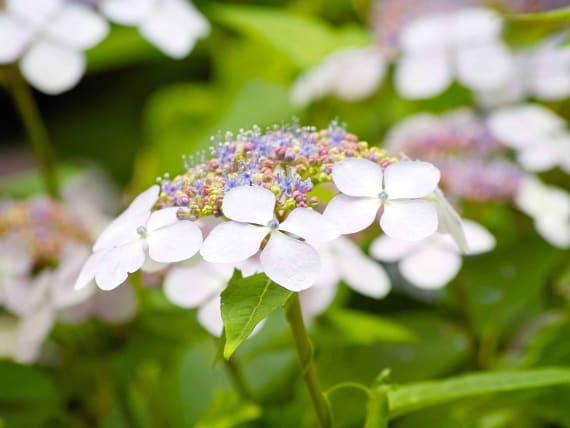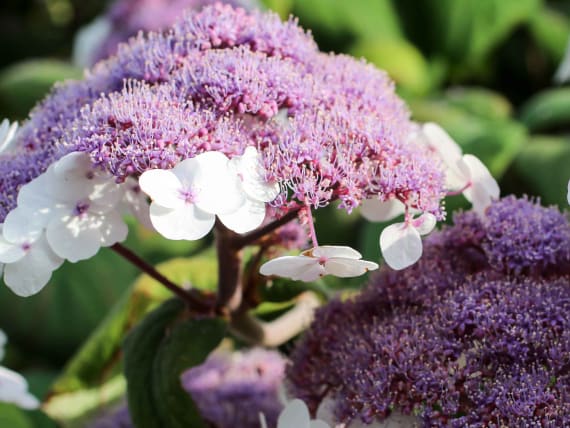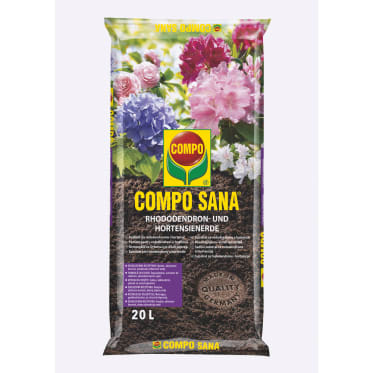Frequent search terms

- COMPO
- Guide
- Plant Care
- Garden
- Garden care
- Hydrangea special: Everything you need to know about hydrangeas
Hydrangea special
All you need to know about the hydrangea
With their colourful floral abundance, they are an evergreen on your windowsill, balcony or in your garden: hydrangeas. If the right variety is selected and they are cared for properly, they mesmerise us throughout the summer with their nostalgic charm. And, thanks to their abundant flowering, they are eye-catchers in both beds and tubs. Find out everything you need to know about hydrangeas and how to care for them here.
How best to care for hydrangeas
Its name reveals what the hydrangea needs for optimal development: 'Hydrangea' comes from Greek and is composed of the words 'hydro' (water) and 'angenion' (vessel). Watering hydrangeas on a regular basis is one of the most important parts of caring for them – this applies to tub plants in particular. Like rhododendron, azaleas and camellias, hydrangeas are among the acidophilic plants that thrive with few nutrients and in acidic soil. You need a special nutrient-rich soil with a low pH value for healthy growth.
Does an extremely dry summer lie ahead? Choose heat-resistant varieties!!
Not all varieties can deal with the heat and the dryness that comes with it. It has been shown that the hydrangea varieties hydrangea aspera, quercifolia and paniculata can withstand hot summers far better than others.

Blue colouring and fertilisation of hydrangeas
For blue hydrangeas, you should make sure to only water with soft water, otherwise your hydrangea might surprise you with pink flowers in the second year. If a blue hydrangea takes on a pink or purple colour, it is a sign that the pH value of the soil does not meet the plant's needs. Pink hydrangeas contain the pigment delphinidin, which creates their blue floral abundance along with the micronutrient aluminium and an acidic soil (pH value of about 4-5). If you use hard water, it increases the pH value of the soil and the aluminium can no longer be absorbed through the roots. With a blue plant, you can give the intense colour a helping hand.
We recommend using a liquid fertiliser tailored to the needs of the plant for fertilising hydrangeas. This way, your hydrangeas get all the nutrients they need for optimal development once a week when they are watered.
How to prune hydrangeas properly
Hydrangeas are pruned differently depending on the variety. If you keep to the following rules, your plants will say thank you with a long life and wonderful floral abundance:
- To ensure that the stems of panicled and wild hydrangeas carry the weight of the flowers in bad weather, they should be pruned in the spring or late autumn. This is the only way for strong shoots and a thick framework to form with plenty of flower heads.
- French hydrangeas, lacecap hydrangeas and climbing hydrangeas develop their flowers the year before. So remove old shoots immediately after the flowering period. Avoid pruning too generously in the spring, only remove dead and frozen parts of the plant above the last buds.
- The Endless Summer variety is an exception to this: Unlike other French hydrangeas, it does not dislike a generous pruning in the spring and summer, sprouting and blossoming again in its full splendour.
The most important varieties at a glance
Hydrangeas: Diverse shapes and colours
Classic
French hydrangea

The French hydrangea is probably the most famous variety. It was brought to Europe from Japan at the end of the 18th century. The large umbels of the subshrub, growing up to two metres tall, blossom in white, blue, pink, red or violet from the end of June until September. The Endless Summer variety is particularly popular because it can form flowers on fresh shoots. That is why it blooms until well into autumn.
Delicate
Lacecap hydrangea

The flowers of the lacecap hydrangea are flatter and more delicate than the French hydrangea; its growth is also more compact and a little denser. Lacecap hydrangeas need a semi-shaded to moderately sunny spot and add a great decorative touch to balconies, terraces and gardens. 'Bluebird' and 'Rosalba' make good substitutes.
ball-shaped
Wild hydrangea

Wild hydrangeas are known for their ball-shaped, bright white flowers. They grace us with their large umbels from June until September. They feel right at home in both flowerbeds and tubs as long as they are put in a shaded spot. Their most famous variety is 'Annabelle'.
Soft
Hydrangea aspera

The hydrangea aspera is a rarity in our native gardens. It grows up to 2.5 metres tall and its leaves and shoots are covered with a grey-white fuzz. The composite flowers of the flat umbels are white, while the fertile flowers can also be violet, blue or pink. Given their impressive size, hydrangea aspera should mainly be planted in your garden.
Tall and slender
Panicled hydrangea

Panicled hydrangeas are usually between 1.5 and 2 metres tall and are available as a shrub or a small tree. The white to cream-coloured, lilac-like panicles sometimes develop a delicate pink colour over time. They develop flowers from June until October.
Trailing
Climbing hydrangea

The climbing hydrangea is a low-maintenance climbing plant that is perfect for adding a touch of green to building walls. It is self-climbing and holds on to masonry with its aerial rootlets. Besides its climbing skills, it is also treasured for its white flowers. The flowering period begins at the end of May and is accompanied by a sweet fragrance reminiscent of elder and jasmine.
How to get hydrangeas through the winter well
You should cover hydrangeas with brushwood or sprigs of fir during the winter to protect against frost so that you can continue to enjoy floral wonders next year, too. This is particularly important for French and lacecap hydrangeas which form their buds during the previous year. If possible, all hydrangeas in pots and tubs should be overwintered in a frost-free place. If you can't move them to a room or winter garden, a sunny spot on the balcony protected from the wind can serve as a winter home. But the pots should have a minimum diameter of 40 centimetres and be protected against the cold with non-woven fabric or sackcloth.
These products are suitable for your hydrangeas




